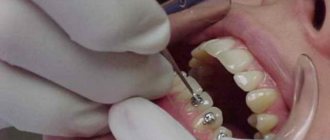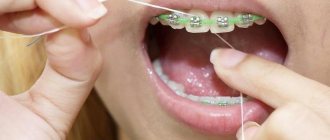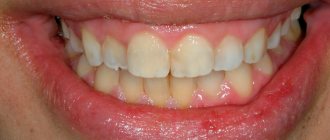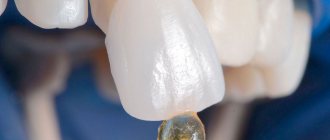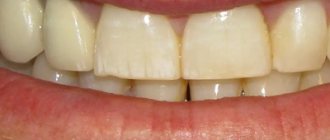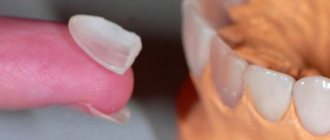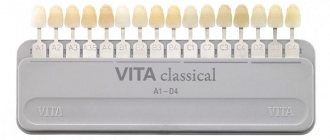24.03.2020
A perfect smile can say a lot about a person. Having straight and beautiful teeth is not a problem today. All oral imperfections can be eliminated with the help of veneers. This is a great opportunity to quickly and painlessly make your smile irresistible.
Veneers are thin ceramic plates that are attached to the front of the tooth. The thickness of such material can be from 3 to 5 mm. Veneers are made in the laboratory, according to individual impressions. They are popular among both women and men. Due to their unique capabilities, such plates are used in dentistry all over the world.
In this article we will help you decide why veneers are needed and in what cases they should be installed.
Contraindications for veneers
It is not recommended to install plates on teeth in the following cases:
- With increased tooth wear.
- If there are no teeth responsible for chewing.
- The patient is involved in extreme sports.
- The patient suffers from bruxism.
- With severe destruction of the inner part of the teeth.
- If there are medium and large sized fillings on the inside.
- With an incorrect bite.
It is also prohibited to do veneers for those people who have bad habits. These include the habit of opening beer bottles with your teeth or cracking nuts.
Dentists do not recommend attaching plates to teeth that have a small layer of enamel. Veneers installed on such dentin will have less strength than those “glued” to a tooth with 0.5 mm enamel.
Indications for installation
Installation of veneers on the front teeth is required to correct the following problems:
- Hue.
If your teeth have turned yellow or darkened, it is not always possible to return them to their natural shade with whitening. Installing veneers allows you to regain your beautiful smile without the use of dangerous whitening chemicals. The same applies to solving the problem of tetracycline teeth. - Cracks.
A crack or chip of tooth enamel is a direct path to the formation of caries and further tooth destruction. The best way to get rid of the problem forever is to use a dental veneer. - Interdental gaps.
Many people experience psychological discomfort due to the fact that the teeth in a row are located at unequal distances from each other. Veneers will help avoid radical treatment with braces and visually correct gaps. - Defects.
Onlays can hide a number of dental defects: short teeth, enamel hypoplasia, wedge-shaped defect, small curvatures, gummy smile (in combination with gum surgery).
Veneers can be placed not only on the front teeth, but also on the side teeth. This little trick will give your face a lifting effect. In Russia, such a procedure is still rare, but in the West it is very popular.
Is it possible to get veneers during pregnancy?
Oral diseases can negatively affect the health of mother and child. Therefore, every woman who registers is required to undergo a consultation with a dentist.
To make pregnancy easy, you should take care of your teeth in advance. Installing veneers is the most gentle way to transform your smile.
Modern materials for prosthetics are not capable of harming a child’s health. The components that make up the raw material do not cause allergies. But despite this, experts recommend treating teeth no later than the second trimester.
Reliable fixation of veneers
The onlays are fixed using a special strong dental glue, resulting in a monolithic “veneer + tooth” structure. The inner surface of the plates has roughness - for better adhesion to dental tissues. When preparing the enamel, the dentist will also create the necessary microrelief. Then the doctor treats the surfaces of the veneer and tooth with special preparations, applies glue and carefully fixes the veneer. If all the nuances of the technology are followed, there will be no problems with falling out veneers. High-quality micro-prostheses will last from 10 to 15 years or more.
Pros and cons of veneers
Veneers, like any dentures, have their advantages and disadvantages. The advantages of this type of prosthetics include the following:
- beautiful and healthy smile;
- the plates do not change color;
- natural teeth will not deteriorate under veneers;
- veneers are made of environmentally friendly material;
- plaque and stones are not formed;
- the service life of ceramic veneers is from 15 to 17 years;
- The tooth is not denervated before attaching the material.
The disadvantages of veneers include their relatively high cost compared to other types of prosthetics: not everyone can afford to make a beautiful smile in this way. In addition, if there is a mechanical impact on the veneers, for example, with an impact or strong pressure, the material may crack. Such teeth are not subject to partial restoration, so in case of any defect, the entire element will need to be replaced.
So, we have looked at cases in which veneers are placed on teeth, and contraindications for their installation, as well as the pros and cons of this type of prosthetics. Despite all the benefits, to make a final decision about whether to get veneers, you need to consult with your doctor.
Methods for installing veneers
Today, dentists offer two installation methods:
- Indirect
. In this case, veneers are made in a laboratory, after which they are tried on, adjusted and installed. The process, on average, takes 14-21 days and requires several visits to the dentist. - Straight
. Used when using composite materials. The technique is similar to filling - composites are applied layer by layer, and then adjusted to the anatomical features of the teeth. The procedure is performed in one visit to the dentist and is indicated for eliminating the most minor aesthetic defects.
The method is selected not only based on the patient’s wishes, but also according to indications, based on the overall clinical picture determined during the initial examination. Both methods are applicable only for living teeth (from which the nerves have not been removed), and to correct the aesthetic problems of dead (pulpless) teeth, the doctor, instead of placing veneers, will offer alternative options.
How to install ceramic veneers
Ceramic veneers are installed after diagnosis and complete dental sanitation. The installation is carried out in several stages:
- The doctor prepares (grinds) the teeth, takes an impression and places temporary veneers;
- Creates a 3D model of future onlays and sends it to the dental technician for work;
- Trying on finished veneers and, if there are no comments, installation.
The whole process takes from 7 to 10 days. Refractory porcelain veneers may take longer to fabricate and install.
What determines the cost of veneers?
The first thing that interests patients who want to make their smile more beautiful is how much does it cost to install veneers and what is the price determined from? The main factor influencing the cost is the material. But we have already talked about this. Now about what, in addition to the material, affects the price of veneers:
- Method of making overlays. Dental technicians use different methods. For example, high-class specialists work with a microscope and create ideal veneers, indistinguishable from natural teeth. Such exclusive linings are more expensive than standard ones made using standard methods. As a rule, an orthopedic dentist works with several dental technicians and the patient can choose veneers to suit his budget.
- Pricing policy of the clinic. “Promoted” dental centers that have been operating for many years set higher prices for their services than clinics that have opened recently and are still little known on the market. Does this mean that the quality of services will be lower? There is no clear answer. It is wiser to focus not on the name of the center or the cost of services, but on the professionalism and experience of the doctor.
Making veneers
Depending on the manufacturing method and material of dental veneers, they are divided into two types: therapeutic made of composite and orthopedic made of ceramics. The first are made literally in the patient's mouth. In this case, composite materials are used, similar to those from which fillings are made. The installation technology is simple: the tooth is ground to the required thickness of approximately 0.3 to 0.7 millimeters, and then a veneer is formed on the tooth surface layer by layer, and the procedure is completed by grinding and polishing. Otherwise, this technique is called restoration.
Placing ceramic onlays is more difficult and will require several visits to an orthopedic dentist. First, the tooth is prepared for the veneer, then an impression is taken, from which the plates are made of ceramics and polished in a dental laboratory or clinic using special equipment. Then the finished structure is fixed on the tooth surface. During the production of the veneer, the patient wears a temporary structure.
Materials
Today, an esthetician dentist has several types of veneers made from different materials:
- Composite
- Ceramic
- Zirconium
Each type has its own pros and cons in terms of reliability, appearance and cost. Most experts recommend making zirconium overlays only in exceptional cases. Zirconium plates require significant preparation of dental tissues before installation. Moreover, this material for veneers has poor adhesion, which means microprostheses will not adhere well.
Veneers without grinding - fact or fiction?
Preparing teeth for veneers raises many questions among patients, and marketers have a lot of opportunities to attract clients to the clinic through loud slogans like “Veneers without grinding!” What's the catch? The fact is that in almost 95% of cases you have to use turning. It is logical that patients who require veneering do not have perfect teeth, and in order to correct their shape and size using microprostheses, preparation is required. Grinding is not necessary if the teeth are small and there are gaps between them. Crowding, medium or large teeth are indications for grinding. Otherwise, you will not get a Hollywood smile, but a pitiful imitation of it, created from Orbit pads.
How does the installation work?
Veneer installation – what is the process? First of all, you need to prepare your teeth. The dentist will remove tartar and the top layer of enamel, then carry out a complete sanitation. This will prevent the development of inflammatory processes under the veneer. The procedure then goes like this:
- The doctor takes an impression of the tooth and sends it to the laboratory. Plates will be made on its basis. At the client's request, temporary plastic onlays will be placed on the ground teeth.
- The laboratory staff makes the veneers, then transfers them to the dentist.
- The patient comes back to see the doctor. The doctor will remove the temporary veneers, and treat the enamel surface with acid and rinse with water.
- An adhesive layer and cement are applied to the prepared surface, then the veneer is attached.
Good to know. If the patient plans to install lumineers, the dentist will only perform sanitation of the oral cavity; there is no need to grind the teeth.
Which veneers are best to choose?
If you compare photos of teeth with veneers before and after their installation, the visual effect will certainly be impressive. However, it is difficult to understand at first glance what material they are made of. Indeed, immediately after installation, both ceramic and composite veneers look great. Because of this, it may be tempting to opt for cheaper composite overlays. If the budget is limited, this choice is justified. But you need to understand that the service life of composite veneers is short - from 4 to 7 years. Ceramic plates last more than 10 years.
Price is not the only selection criterion. The type of defect that you plan to correct with veneers matters. For example, if you only need to “whiten” your smile, lumineers are a good option. There is no need to prepare teeth for them and they look as natural as possible. But, if the problem is a shape defect, thin lumineers will not be able to hide it.
Which veneers to choose should be decided together with your doctor after a detailed diagnosis and determination of all the nuances.
How are veneers different from braces?
Both veneers and braces are used to eliminate defects and make your smile beautiful. But they solve this problem in different ways:
- Veneers are permanent coverings that are attached to the surface of the tooth and remain there forever (unless there is a need to replace them). They create the necessary visual effect.
- Braces are a removable orthodontic structure whose task is to physiologically change the position of teeth in the dentition and correct the bite. Once the goal is achieved, the braces are removed.
Not in all cases, veneers are enough to eliminate the defect. For example, if a patient’s teeth are severely crooked or have an incorrect bite, it is not recommended to install veneers. In order to create the effect of an even row with their help, the teeth will have to be sharpened greatly, and this will significantly speed up their destruction. In case of such defects, it is advisable to straighten the teeth using braces.
What are Lumineers?
Lumineers are a separate type of dental coverings. They differ from veneers in thickness, which does not exceed 0.2 mm, and in the installation method. Due to the thinness of the plates, in most cases they are installed without grinding the tooth enamel. Lumineers are installed if there is no need to visually correct the shape of the tooth. The main disadvantages of lumineers are:
- Low strength. It is physically impossible to provide it with a minimum thickness of 0.2 mm;
- High price. Lumineers are the most expensive type of veneers.
How long does it take to replace veneers?
The service life of veneers depends on many factors:
- Material. Ceramic ones are more durable;
- The patient’s lifestyle, how carefully he “handles” dental veneers;
- Doctor's professionalism. If mistakes were made during installation, for example, the materials were not dried correctly, the veneers will not last long.
There is no clear period after which the linings must be replaced. This should only be done if there is an objective need. For example, if the veneer:
- Broken off;
- Peeled off;
- Darkened (relevant for composite overlays).




